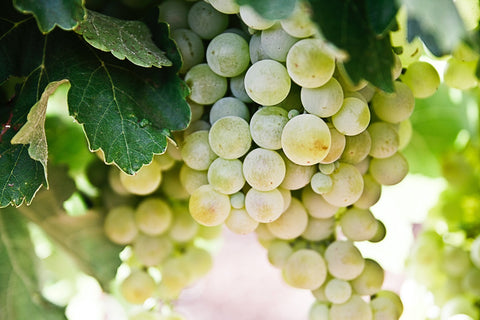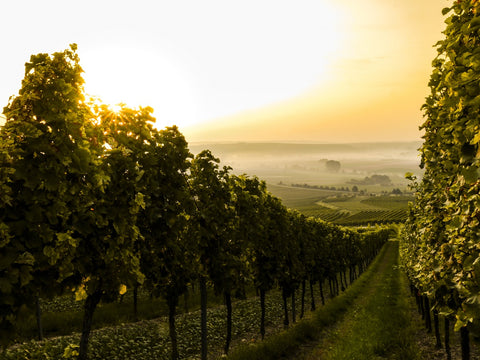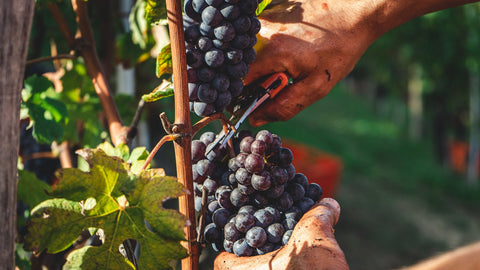Back to School
It's September, and we're going back to school to learn the basics about wine. If you're just beginning to develop an interest in wine, or simply want to know a little more, this is the place to start. Over the next 5 weeks we'll be sharing our best tips, busting wine myths and exploring together the basics about what makes this beverage so beguiling. We've also put together a case of wine that you can use to drink along with us.
What is wine?

Very simply, it is an alcoholic beverage made by fermenting grape juice. These are not your usual supermarket grapes though. Wine grapes tend to be smaller, with thicker skins. The colour of the grape skin is important as this is going to have a big impact on what the wine is like, depending on how it is handled in the winery. Fermentation is where the sugar converts into alcohol.
How is wine made?

Wine is nothing without quality fruit, so first you need to grow your grapes. Vines need plenty of sun, enough water and weather that isn’t too extreme. Areas with cooler climates need vineyards in locations where they can maximise their sun exposure, while very warm areas will find the best grapes grow in places where there is a cooling factor from winds or mists that stop the grapes overripening. You’re looking to achieve the right balance of flavours, sugar and acidity. Once your grapes are ripe, you’re ready to harvest.

Harvesting can be done by machines – if your vineyard is on flat land – or by hand, if you're being more selective or your vineyard is on a steep slope. Once picked, grapes may be sorted and removed from the stems ready for making wine.
White wine
White grapes are crushed and pressed and all the skins and seeds are removed. The juice is then fermented by adding wine yeast (or in the case of natural wines, allowing the yeasts that are naturally found on the grapes to start the fermentation – with less predictable results.) The winemaker chooses whether they want to do this in steel or concrete or oak barrels – each will have an effect on the wine. Once fermented the winemaker chooses whether to further mature the wine which can add more flavour and complexity to the wine.
Rosé Wine
Rosé wine is made by crushing red-skinned grapes and leaving the juice in contact with the skins for a few hours. The longer the time in contact with the skins, the deeper the colour. The juice is then removed from the skins and fermented. Rosé wine is not usually fermented or matured in oak barrels. The aim is fresh, fruity flavours.

Red Wine
Red Wine is made by fermenting the juice while it is in contact with the red skins, and they are left in contact for around 5-21 days while they ferment. The juice is then removed and the grape skins are pressed to extract every last drop of wine. The colour and flavour of red wine comes from the skins. The acidity can be high at this stage so most red wines go through another natural process called malolactic conversion that softens the acidity and makes it rounder. The winemaker then chooses whether to blend the wine and mature it before bottling.
Orange Wine
Orange wine is better described as skin-contact white wine. It is made in a similar way to red wine. Instead of quickly squeezing out the juice, white grapes are fermented with the skins and seeds and left in contact for anything from 1 to 6 months. This creates an amber hued wine that has more tannins, dryness and complexity.
Sparkling wine
Sparkling wine is made as a white wine and then refermented either in tank (Prosecco) or bottle (Champagne, Cava). One of the natural by-products of fermentation is carbon dioxide, so all quality sparkling wine will have naturally created bubbles. To get the second fermentation, a little extra sweet grape juice is added along with yeast. In traditional method fizz (that is, Champagne or Cava), once fermentation is complete, the wine is aged for months or years. Once ready, the yeast is then removed from each bottle before rebottling and sealing with a wire caged cork to contain all the pressure of the bubbles in the bottle.
Pétillant Natural (Pét Nat) wines are made by pausing the initial fermentation of the wine by chilling it, before resting it for months before bottling and allowing the original fermentation to finish in the bottle.
The building blocks of wine
So when you finally get some wine in your glass, what you have is a combination of acidity, sugar, alcohol and tannins. These make up the structure of the wine and create sensations in your mouth, so the key is making sure these elements are balanced and working in harmony. Too much sugar and the wine won’t be as refreshing and can taste dull. Too much acidity and the wine will be harsh and unpleasant. Too much alcohol and you feel the burn, but just enough gives the wine extra body. Tannins will overwhelm your mouth and taste bitter if they are too strong (just think about how an over-brewed cup of tea feels when you drink it.)
This framework also helps preserve the wine and make it more food friendly.
How to taste wine
So here we're not telling you how to drink wine - you already know how to do that. We’re looking instead at a simple process for analysing the wine. Might sound a bit dull, but through this we can better understand and appreciate the flavours and textures that make up the sensory experience.
We do this using a few simple steps:
- We look at it.
We're looking at the colour, how deep and intense it is or how light, whether the colour is the same at the in the middle of the wine and the edge. We're looking at how the wine coats the glass.
- We smell it.
This sounds obvious, but it's where most of the flavour is, so it makes sense to pay attention to the aroma. We're getting a feel for how intense the aroma is, what flavours you can recognise, whether they're floral, fruity, or savoury, or spicy, or stinky. You can swirl the wine around the glass if you want to release a bigger aroma but it's not essential.
- We take a sip
Once you've had a good smell, you should take a sip, but before swallowing you should roll the wine around your mouth to cover all of the tongue. You're probably doing it without thinking about it, we're just nudging you to pay attention to it. While it’s there you can think about how it feels. Is it round and juicy? Zesty? What sensations do you notice? Do you feel the alcohol?
- We swallow and savour
A lot of the flavour of a wine can be revealed just after you’ve swallowed and one sign of quality to look for is how long the flavour lingers in your mouth. You’re then left with your thoughts about the wine. Is there a drying grip of tannins? Are these elements in balance? It is simple or complex? Did you like it?
Here are some useful vocabulary terms you could use when tasting:
acidity — the liveliness and crispness in wine that activates our salivary glands
aeration — this is what we’re doing when we swirl the wine in the glass. It’s trying to add oxygen to round out and soften a wine
ageing — holding wine in barrels, tanks and bottles to develop the flavours
alcohol —the product of fermentation of sugars by yeast
aroma — the smell of wine
astringent — the name we use for harsh, bitter and drying sensations in the mouth caused by high levels of tannin
balance — a term for when the elements of wine – acids, sugars, tannins, and alcohol – come together in a harmonious way
barrel — the oak container used for fermenting and ageing wine
blend — a wine made from more than one grape variety
body/weight — the sensation describing the fullness of wine in the mouth. A wine can be light, medium, or full-bodied
complex — a wine with lots of aromas, nuances, and flavours
cork taint — undesirable aromas and flavours in wine often associated with wet cardboard or mouldy basements
corked — the term for a wine that has suffered cork taint (not wine with bit of cork floating about in it)
dry — a taste sensation often attributed to tannins and causing puckering sensations in the mouth; the opposite of sweet
earthy — an aroma or flavour reminiscent of damp soil
fermentation — the conversion of grape sugars to alcohol by yeast
finish — the impression of textures and flavours lingering in the mouth after swallowing wine
fruity — term for wines that have strong smells and flavours of fresh fruit
full-bodied — a wine high in alcohol and flavours, often described as “big”
herbaceous — a term for aromas and flavours of fresh herbs (e.g., basil, oregano, rosemary, etc.)
hot — a description for wine that is high in alcohol
lees — sediment consisting of dead yeast cells, grape pulp, seed, and other grape matter that accumulates during fermentation
length — the amount of time that flavours last in the mouth after swallowing wine; a lingering sensation
mouth-feel/texture — how a wine feels on the palate; it can be rough, smooth, velvety, or furry
nose — a term describing the aromas of a wine
oak/oaky — tasting term denoting smells and flavours of vanilla, baking spices, coconut, mocha or cedar created by barrel-aging
oxidation — wine exposed to air that has undergone a chemical change
spicy — a tasting term used for aromas and flavours reminiscent of black pepper, bay leaf, baking spices, oregano, rosemary, thyme, saffron or paprika found in certain wines
structure — a term for the building blocks of the wine fruit, alcohol, acidity, and tannins
sweet — wines with noticeable sugar
tannins — the compound in wines that leave a bitter, dry, and puckery feeling in the mouth
vegetal — use this if you notice aromas or flavours of fresh or cooked vegetables. Bell peppers, grass, and asparagus are common “vegetal” descriptors.
vintage — the year the grapes were harvested







Leave a comment (all fields required)